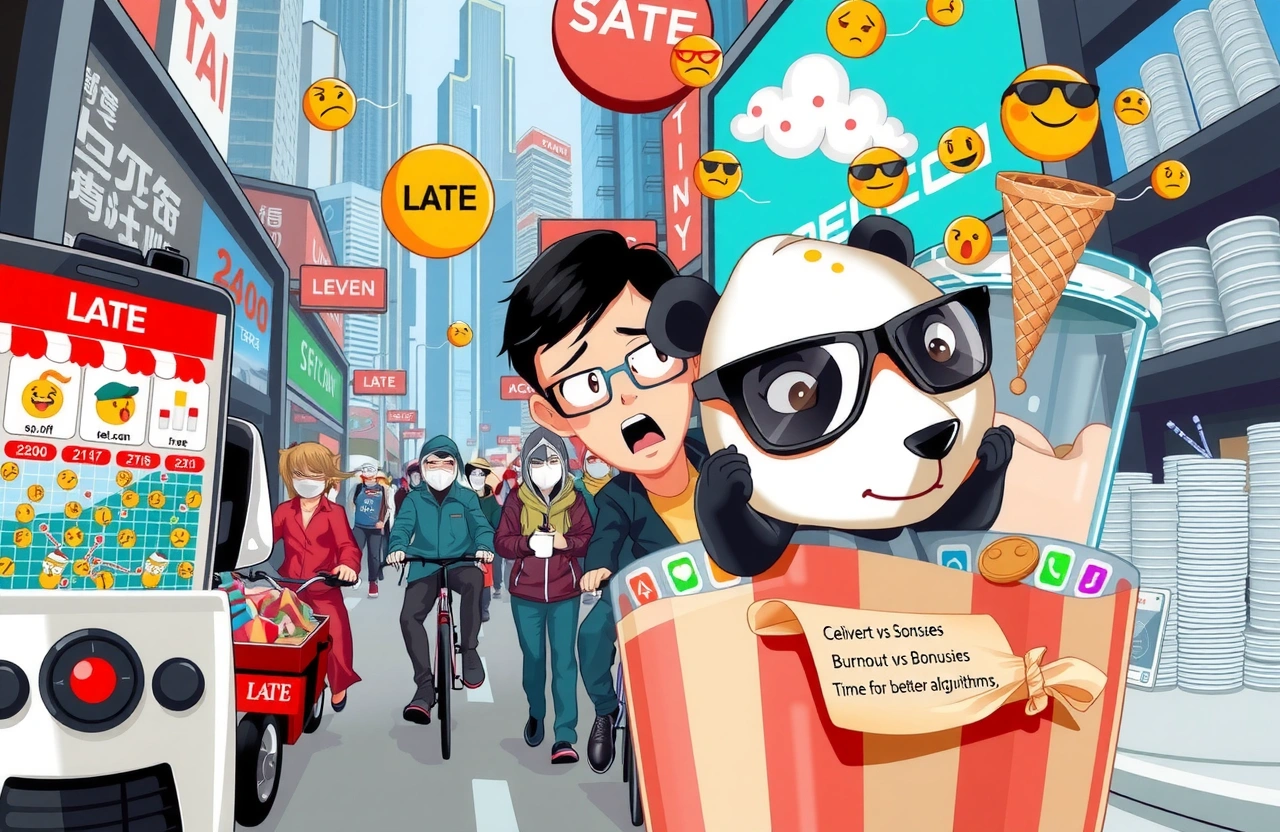The whir of overworked blenders echoed through Shanghai’s NOWWA Coffee shop as Wang Rui (王睿), the store manager, surveyed a battlefield of scattered receipts and stacked orders. Baristas scrambled amid mechanical groans – machines pushed beyond capacity as midnight melted into 3 a.m. This scene, duplicated across China last weekend, marked the frontline of an escalating delivery war between tech titans. When Meituan, Ele.me (饿了么), and JD.com unleashed unprecedented subsidies, consumers flocked toward 1-cent bubble teas and 5-yuan coffee deals, inadvertently forging a pressure cooker for thousands of workers. As Receipts piled ankle-high and delivery apps crashed under demand, the human infrastructure powering China’s $300 billion food delivery industry buckled under a perfect storm of algorithmic fury and capitalist competition.
Summary of Key Developments:
– Delivery platforms triggered record-breaking orders through aggressive subsidies, with shops reporting 50-300% order surges and riders delivering 30% more packages daily
– Staff at brands like Mixue Bingcheng (蜜雪冰城) and HeyTea worked 18-hour shifts, enlisting family support to manage queues while facing burnout without overtime pay
– Riders navigated relaxed delivery rules amid system failures, with earnings temporarily doubling but facing physical exhaustion and heat stress during peak demand
– Bubble tea and coffee emerged as subsidy targets due to high margins, social media virality, and standardized production enabling rapid scale
– Industry projections indicate subsidies may continue through August, forcing chains to redesign workflows for sustainable operations post-campaign
Ground Zero: Bubble Tea Shops Under Siege
Scattered receipts formed paper snowdrifts around mix stations at a Mixue Bingcheng outlet in Shandong – visual proof of production lines pushed past rational limits. This franchise, accustomed to ¥13,000 daily weekend revenue, saw numbers explode to ¥17,000 on July 5 alone, producing over 2,700 drinks in 24 hours. The catalyst? Platform promotions slashing prices to unprecedented lows: ¥3.70 combos (originally ¥16) on Meituan, 1-cent specials via Douyin, and 5-yuan two-drink deals with free delivery on JD.com. With orders materializing faster than human hands could assemble cups, shops descended into functional chaos.
Operating Systems in Distress
Chen Ming (谌鸣), Head of E-commerce at Yihetang (益禾堂), describes supply chain gymnastics unseen in the brand’s 8-year operation. Stores extended hours from 8:30 a.m. to 3:00 a.m. while scrambling through three critical adaptations. Personnel strategies ballooned shifts from 2 to 4 workers minimum, recruiting relatives during crises and offering higher temporary wages. Inventory protocols mandated 30% buffer stock on essentials like tapioca and milk caps, yet many locations depleted reserves by Saturday evening. Equipment limits bottlenecked output when blenders malfunctioned from overheating, forcing NOWWA Coffee’s Youyou Century Square location to shutter briefly despite queues. As Wang Rui notes: “Productivity plateaus become painfully physical – our machines have maximum cycles per hour we dangerously exceeded.”
The Human Cost of ‘Brewed Gold’
Behind viral social media posts flaunting refrigerators stocked with discount drinks emerged harsher realities. One Mixue employee’s online diary captured the toll: 15 hours continuous work assembling orders while fielding irate calls about delayed deliveries. Without performance bonuses tied to sales volume, staff gained little beyond exhaustion as platforms reaped user growth. “Cashing in means customers win, platforms win, our brand wins – but floor workers? Just more work and complaints,” shared one Nanjing barista. This delivery war-fueled tension spotlighted a fissure in gig economy rewards: When corporate battles intensify, frontline laborers absorb operational shockwaves.
Riders at the Breaking Point
Liu Hui (刘辉), Team Leader at Meituan’s Xujiahui station in Shanghai, checked order dashboards on July 6 to startling metrics: 4,370 deliveries processed versus a typical 3,200. His star rider completed 134 trips (typically 100), finishing near midnight in 34°C heat. The surge defied standard patterns – peak afternoon demand stretched past 10 p.m., while riders grappled with abnormally high volumes of cheap bubble teas. “Transporting 8 cups for ¥0.10 feels absurd, but we’re the ones maneuvering those drinks through traffic,” Liu remarked. Across China, delivery personnel faced dual stressors: physical strain from increased volume and psychological pressure navigating broken systems.
Algorithmic Failure and Improvised Solutions
As digital infrastructure buckled, platforms enacted emergency protocols unveiling the fragility beneath their tech-driven facade. In Chongqing, Ele.me rider Liao Zemiao (廖泽萌) witnessed surreal system adjustments: Time limits for a 500-meter delivery extended from 20 minutes to 150 minutes as pickup queues ballooned. When shops bottled deliveries for 50+ simultaneous orders, Ele.me implemented atypical rule suspensions on July 5 – no penalties for first 10-minute delays and full waiver for post-9 p.m. deliveries. Liao reflects: “We became traffic controllers negotiating between frozen apps and furious customers.” The collateral damage included critical service failures: temperature-sensitive cheese foam toppings melting during holdups, incorrect order handoffs, and rising customer conflicts over refunds. This delivery war exposed how thin real-world operational buffers become when algorithms expect infinite scalability.
Earnings Windfalls Mask Unsustainable Burdens
Despite temporary income jumps, riders voiced grim realities beneath the bonus hype. Platform incentives pushed daily pay to ¥800-1,000 during peak weekend hours – nearly doubling standard earnings – through combination tactics: delivery fee bumps from ¥5.8 to ¥8 per trip, stacked heat-wave supplements, and volume-based prizes. But this calculation ignored physical depreciation. One veteran Shanghai rider requested anonymity to describe debilitating outcomes: severe leg cramps requiring massage therapy and three riders requiring IV fluids from acute heatstroke. Liao observes newer recruits struggling with complex delivery loads: “Untrained riders misfile orders constantly when swamped. They earn fast cash but burn out faster.” This delivery war phenomenon reveals an uncomfortable paradox: Economic boosts for gig workers often come tethered to physical wreckage.
Market Mechanics of Beverage-Based Subsidy Wars
Why did milk tea and coffee ignite this conflict? Analysts identify beverage products as strategic ammunition in platform competition. Margin structures allow chains to absorb 15-20% discounting while retaining profitability, starkly contrasting with prepared foods requiring costlier ingredient subsidies. Product standardization enables scalability – unlike customized dishes, bubble teas follow formulaic builds shops replicate rapidly. Social sharing mechanics also prove crucial: Consumers eagerly post haul photos online, triggering viral (#奶茶自由) campaigns like “Milk Tea Freedom” that amplify marketing organically. JD.com’s late entry into food delivery this spring catalyzed this latest escalation, forcing Meituan and Alibaba’s Ele.me to counter with deeper discounts for market defense.
Volume Versus Profit: The Business Reality
Industry leaders exhibit cautious pragmatism regarding the costs of this delivery war. Yihetang confirms fascinating economics: despite individual drink margins contracting 7-11% under promotions, overall profits doubled year-on-year through sheer volume as orders climbed 3-4X pre-campaign averages. NOWWA’s Wang Rui acknowledges similar physics: Currently, the shop goal is monetizing surprise traffic. We accept compressed profit per cup because customer acquisition and frequency lifts matter more. Business intelligence teams monitor critical metrics: store-level customer conversion rates post-discount, member subscriptions from promotion sign-ups, and repeat order patterns indicating loyalty shifts. Ryanne Huang, consumer analyst at DZT Research, cautions: “Bubble tea optimizes for splashy numbers but risks normalizing unsustainable pricing. Chains risk post-campaign retention crashes.”
The Handshake of Physical and Digital Systems Under Stress
Peak weekend volumes spotlighted cascading failure points across traditionally siloed operations. Production bottlenecks emerged when printer queues jammed at shops as staff prioritized drink-making over dispatch protocols, causing delivery pileups. Supply chain sensors proved inadequate for instant adjustments despite IoT promises – dairy dispatches calculated for standard volumes forced creative solutions like oat milk substitutions at HeyTea branches when refrigerator space ran out. More critically, human resource pipelines remained dangerously inefficient: Job boards needed days to connect shops with vetted temporary staff while machines could ramp up instantly but required manual maintenance. Chen Ming underscores painful learnings: “Automation handles volume – humans absorb volatility. This delivery war exposed we exceeded current frameworks for volatility management.”
Beyond the Battle: Endgame Strategies
Industry predictions suggest these delivery wars may rage until August, but chains recognize subsidy reliance as unsustainable. Yihetang prepares for the “post-subsidy era” through structural adjustments that rewrite crisis response patterns. Dynamic staffing algorithms now trigger alerts predicting hourly demand variance, enabling proactive shift adjustments rather than reactive family mobilization. Supply chains integrate AI matching to synchronize mid-campaign inventory redistribution between hub stores and overwhelmed branches. Training curricula now simulate crisis scenarios via VR modules preparing staff for technical failures and customer conflict resolution. Profit protection strategies segment campaigns: Lower-margin brands lead acquisition pushes while premium labels like Nayuki employ subsidies sparingly to preserve exclusivity.
Realigning Platform Accountability
The human toll documented during this pressure test sparks hard questions about platform ethics and future design. Delivery personnel advocate introducing fatigue sensors integrated with app interfaces – slowing order assignments after intense activity periods rather than pushing riders toward physical collapse. Shop owners demand mandatory advance notice for mega-campaigns and economic simulation tools forecasting staffing/equipment needs. Worker protection groups propose bonus structures sharing platform gains with production-line staff who absorbed decades of wage suppression. Beijing University economics professor Liu Zhe (刘哲) warns: “Unchecked delivery wars economically incentivize the sacrifice of workers’ wellbeing. Without checks, this billion-user upgrade drives exploitation in modemized packaging.”
In six summer days, China witnessed consumer inflation provide bustling drink shops and gig workers experiencing distinctly correlated deflation – that of bodily endurance and psychological resilience as they bore delivery war pressures. Training thresholds now exist towards a better-balanced ecosystem: responsive staffing frameworks, ethical algorithms, and mutual value distribution. Brands leveraging this moment for operational evolution – not exhausted humans sustaining broken sums – will define post-campaign competitiveness. Because despite the flood of cheap milk tea, exhausted workers disclosed a vital insight: human endurance has non-negotiable limits that digital projections cannot overwrite. Reflect when hunting your next deal: Pressures extend far beyond the app screen to individuals paying actual human costs. Check your platform loyalty against sustainability commitments as these delivery wars unfold.




